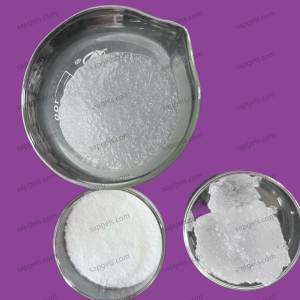聚丙烯酸钠 is a 超吸水性聚合物 renowned for its exceptional capacity to soak up and retain water far beyond its own weight. This incredible material finds utility in a range of applications, from baby diapers to agricultural aids. Let’s explore the mechanisms behind sodium polyacrylate, how it functions, how it’s produced, and its durability.

The Mechanism Behind Water Absorption
The impressive water-absorbing ability of sodium polyacrylate is rooted in its chemical structure. As a polymer, sodium polyacrylate consists of long chains of repeating units derived from acrylic acid. These chains are linked through a process known as polymerization and include numerous sodium ions.
Upon contact with water, the polymer’s sodium ions attract water molecules into the structure via osmosis. This causes the sodium ions to separate from the polymer chain, creating negatively charged sites along the backbone. Water molecules, which are polar and slightly positively charged, are drawn to these sites, leading the polymer to swell and transform into a gel-like substance.
How Sodium Polyacrylate Works
The functionality of sodium polyacrylate can be summarized in the following steps:
- Contact with Water: When dry sodium polyacrylate meets water, the water molecules are attracted to the sodium ions and the hydrophilic parts of the polymer.
- Absorption and Swelling: Water molecules infiltrate the polymer structure, adhering to the negatively charged sites. This causes the polymer chains to expand, forming a gel as they absorb water.
- Reaching Equilibrium: Absorption continues until equilibrium is achieved, where the osmotic pressure driving water into the polymer balances with the elastic forces of the swollen polymer network.
Production of Sodium Polyacrylate
The creation of sodium polyacrylate involves several key steps:
- Polymerization: Acrylic acid monomers are polymerized to form long polymer chains through free radical polymerization.
- Neutralization: The polymerized acrylic acid is neutralized with sodium hydroxide, converting it into sodium polyacrylate and introducing the essential sodium ions.
- Drying and Grinding: The resulting gel is dried to remove excess water and then ground into a powder or granule for ease of use in various applications.
Durability of Sodium Polyacrylate
The lifespan of sodium polyacrylate varies based on its application and environmental conditions. In a dry, stable environment, it can retain its water-absorbing capabilities indefinitely. However, once it absorbs water and forms a gel, its stability can differ:
- In Diapers and Hygiene Products: Sodium polyacrylate in these products is intended for single use. Once it absorbs liquids, it is disposed of after use.
- In Agricultural Applications: Used in soil to retain moisture, sodium polyacrylate can last from several months to a few years, depending on factors such as soil composition, temperature, and microbial activity.
- Environmental Degradation: Over time, exposure to UV light, heat, and microbes can degrade sodium polyacrylate. This degradation process can take several months to years.
结论
Sodium polyacrylate stands out as an extraordinary material with unique water-absorbing properties that are beneficial across various industries. Its ability to absorb and retain water stems from its polymer structure and sodium ions that attract water molecules. The production process involves polymerizing and neutralizing acrylic acid, followed by drying and grinding. While sodium polyacrylate can last indefinitely in a dry state, its longevity in practical applications depends on environmental conditions and usage.
Whether in diapers, agriculture, or other uses, sodium polyacrylate showcases the remarkable potential of polymer science in addressing everyday challenges.

